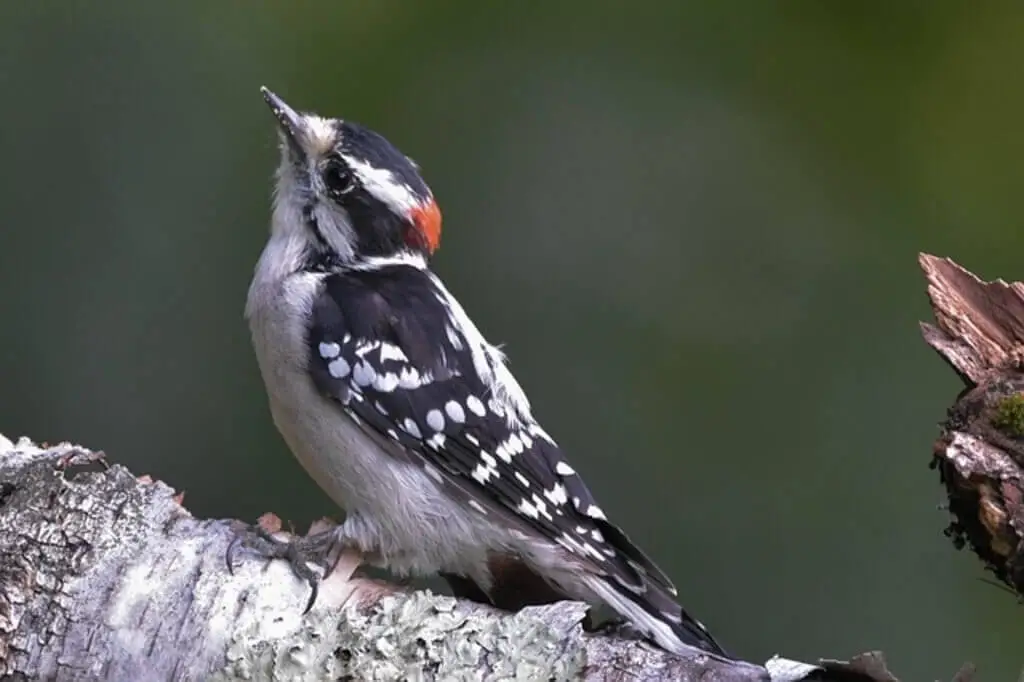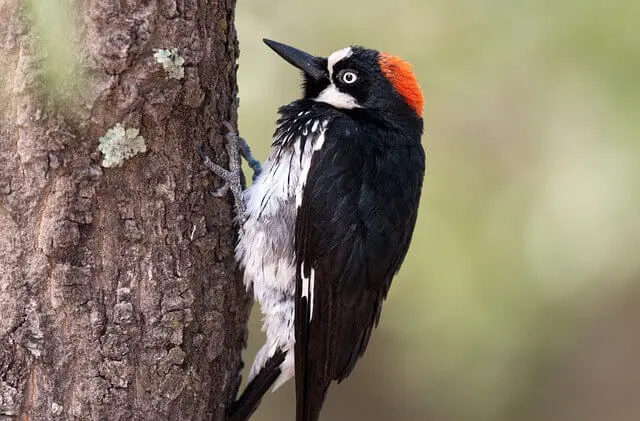Birdwatching offers the joy of discovering and identifying various bird species. The Downy Woodpecker, with its distinctive black and white plumage, is a common favorite. However, many birds can look strikingly similar, making identification tricky. In this guide, we’ll explore 10 birds that look like Downy Woodpeckers, helping you distinguish between these look-alikes and enhance your birdwatching experience. Let’s dive in!
Table of Contents [show]
Birds That Look Like Downy Woodpeckers
Downy Woodpecker (Overview)

The Downy Woodpecker (Picoides pubescens) is a small, black and white woodpecker that is found throughout much of North America, from Alaska to Florida. They are commonly found in deciduous forests and woodlands, as well as parks and suburban areas with trees.
The Downy Woodpecker is the smallest woodpecker in North America, measuring between 5.5-6.7 inches (14-17 cm) in length and weighing between 0.7-1.0 oz (20-28 g). They have a black and white striped pattern on their head and back, with a white belly and wings that are black with white spots.
The males have a small red patch on the back of their head. Downy Woodpeckers feed on insects, seeds, and berries, and are known for their drumming on trees to communicate with each other. They are also cavity nesters, using holes in trees for their nests.
| Characteristic | Measurement |
|---|---|
| Range | North America |
| Habitat | Deciduous forests, woodlands, parks, suburbs |
| Length | 5.5-6.7 in (14-17 cm) |
| Weight | 0.7-1.0 oz (20-28 g) |
| Wingspan | 9.8-11.8 in (25-30 cm) |
Hairy Woodpecker
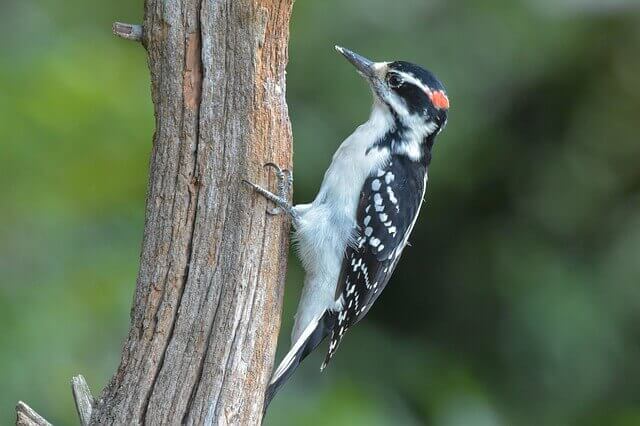
Characteristics:
- Medium-sized woodpecker species.
- Primarily black and white with distinct markings.
- White belly and underparts.
- Solid black crown and back.
- Long, chisel-shaped bill ideal for drilling into trees.
- Males and females look quite similar, with no significant differences in plumage.
Similarities: Like most woodpeckers, Hairy Woodpeckers use their bill to drum on trees in a rhythmic pattern. They share similar black and white plumage with Downy Woodpeckers, which can sometimes lead to confusion. Both species have a white underside and back with black wings and tail feathers. They both have a distinctive white patch on their wings, which is a notable field mark.
Differences: Hairy Woodpeckers are slightly larger than Downy Woodpeckers, with a more substantial bill. The bill of Hairy Woodpeckers is longer and thicker than that of Downy Woodpeckers. While both species have similar black and white patterns, the size and proportions of these patterns can vary, with Hairy Woodpeckers having larger and more extensive markings. Hairy Woodpeckers lack the small white spots that Downy Woodpeckers have on their wings.
| Characteristic | Measurement |
|---|---|
| Range | North and Central America |
| Habitat | Mature forests, forest edges, suburbs, parks, open woodlands of pine and oak |
| Length | 7.0-10.3 in (17.8-26.1 cm) |
| Weight | 1.5-3.5 oz (42.6-99.2 g) |
| Wingspan | 13.0-16.0 in (33-40.6 cm) |
Great-spotted Woodpecker
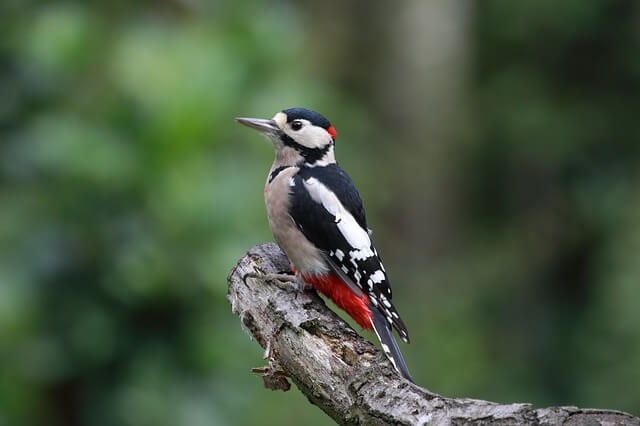
Characteristics:
- The Great Spotted Woodpecker is a medium-sized woodpecker species.
- They have striking black and white plumage.
- Their black wings are adorned with large white spots.
- Males feature a red patch on the back of their heads, while females have a black crown.
- They have a strong, chisel-shaped bill for drilling into tree bark.
- Great Spotted Woodpeckers have a distinctive, undulating flight pattern characterized by a series of rapid wingbeats followed by short glides.
Similarities: Like many woodpeckers, Great Spotted Woodpeckers are skilled at drumming on trees in search of insects and for territorial communication. They share a common black and white coloration with some other woodpecker species, which can sometimes lead to confusion in identification. Both males and females of the species have a white belly and black wings with prominent white spots.
Differences: Great Spotted Woodpeckers are distinguishable from other woodpecker species by their size and specific plumage characteristics. They are larger than some smaller woodpeckers, like the Downy Woodpecker and Hairy Woodpecker. The presence of a red patch on the back of the head in males is a key difference from many other woodpecker species. Additionally, the undulating flight pattern of Great Spotted Woodpeckers can be unique and help in their identification when seen in flight.
| Characteristic | Measurement |
|---|---|
| Range | Great Britain, Eurasia, Japan, Northern Africa, North America (some areas) |
| Habitat | Deciduous forests and woodlands, parks, gardens |
| Length | 8.0–9.5 in (20.3-24.1 cm) |
| Weight | 2.4–3.6 oz (68–102.1 g) |
| Wingspan | 12.8-15.2″ in (32.4-38.6 cm) |
Ladder-backed Woodpecker
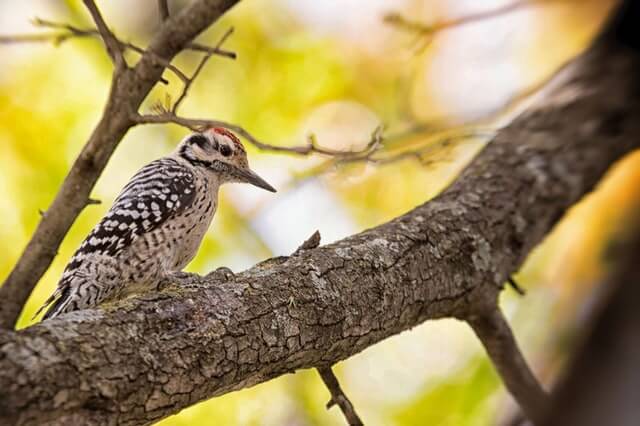
Characteristics:
- Ladder-backed Woodpeckers are small to medium-sized woodpecker species.
- They have striking black and white markings on their plumage.
- These birds feature a distinctive ladder-like pattern on their back, which gives them their name.
- They have a white belly and underparts.
- Ladder-backed Woodpeckers have a black crown and nape.
- Males often have a small red patch on the crown, which is absent in females.
- They have a short, pointed bill adapted for drumming on trees and probing for insects.
Similarities: Like many woodpecker species, Ladder-backed Woodpeckers use their bill to drum on trees in a rhythmic pattern. They share the black and white plumage common to woodpeckers and have a white patch on their wings. Additionally, they have a similar feeding behavior, foraging for insects under tree bark.
Differences: Ladder-backed Woodpeckers are smaller than some larger woodpecker species like the Hairy Woodpecker. Their ladder-like pattern on the back is a distinctive feature not found in other woodpecker species. While males may display a small red patch on the crown, this is not present in females. Unlike some woodpeckers, Ladder-backed Woodpeckers lack extensive white markings on their wings or tail feathers.
| Characteristic | Measurement |
|---|---|
| Range | Southwestern United States, Mexico and Central America |
| Habitat | Pinyon pine, and juniper woodlands, deserts, and thorn forest |
| Length | 6.2-7.2 in (15.7-18.3 cm) |
| Weight | 0.6-1.8 oz (17-51 g) |
| Wingspan | 13.1 in (33.2 cm) |
Acorn Woodpecker
Characteristics:
- Acorn Woodpeckers are small to medium-sized woodpecker species.
- They have a distinctive and striking appearance.
- Their plumage is black and white with bold facial patterns.
- Acorn Woodpeckers have a black cap on their head and a white throat.
- They display a unique pattern of white, black, and red on their face.
- Their eyes are surrounded by a white ring.
- They have a sharp, chisel-like bill that is well-suited for drilling into trees.
- Males and females have similar plumage, making it challenging to distinguish them visually.
Similarities:
Like most woodpeckers, Acorn Woodpeckers use their bill to drum on trees in a rhythmic pattern. They also have the characteristic woodpecker black and white plumage, which distinguishes them as members of this bird family. Similar to other woodpeckers, they are skilled at clinging to vertical surfaces and have strong feet with two forward-facing and two backward-facing toes.
Differences:
Acorn Woodpeckers have a unique and eye-catching facial pattern with a black cap on their head and a white throat, while some other woodpecker species have more subdued head markings. One of the most notable differences is their behavior of storing acorns in granary trees, which is not commonly seen in other woodpecker species. They have a distinctive and prominent “laughing” call that sets them apart from other woodpeckers’ vocalizations.
| Characteristic | Measurement |
|---|---|
| Range | Southwestern United States, south through Central America, down to Colombia |
| Habitat | Oak and mixed oak-evergreen forests near mountains and foothills |
| Length | 7.4-9.2 in (18.8-23.4 cm) |
| Weight | 2.2-3.3 oz (62.4-93.6 g) |
| Wingspan | 13.7-17 in (34.8-43.1 cm) |
Yellow-bellied Sapsucker
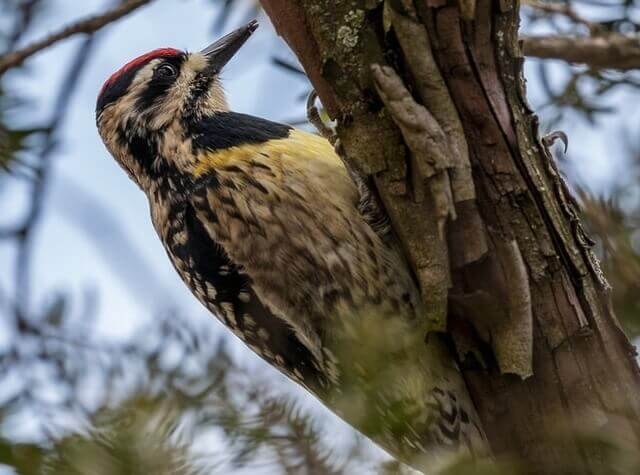
Characteristics:
- Yellow-bellied Sapsuckers are medium-sized woodpecker species.
- They have distinctive plumage featuring a combination of black, white, and red.
- These birds have a white face and throat with a black head and back.
- They have a bright red crown and a bold red throat patch.
- Yellow-bellied Sapsuckers have a yellowish belly and undertail.
- They possess a long, slender bill, well-suited for extracting sap from trees.
- Males and females have similar plumage, but males may have slightly brighter red markings.
Similarities: Like other woodpecker species, Yellow-bellied Sapsuckers engage in drumming behavior on trees, creating a slow and rhythmic pattern. They share some common features with other woodpeckers, such as a chisel-shaped bill used for drilling and a zebra-like pattern of black and white on their wings and back.
Differences: Yellow-bellied Sapsuckers can be distinguished from other woodpeckers by their unique combination of colors and markings. While they may share some similarities with other woodpeckers in terms of bill shape and drumming behavior, their bright red crown, throat patch, and distinctive yellow belly set them apart. Additionally, their specific range and habitat preferences may differ from other woodpecker species, contributing to their uniqueness within the woodpecker family.
| Characteristic | Measurement |
|---|---|
| Range | Eastern North America |
| Habitat | Woodlands, hardwood and conifer forests |
| Length | 7.0-8.8 in (17.8-23.4 cm) |
| Weight | 1.5-2.0 oz (42.5-56.7 g) |
| Wingspan | 13.3-15.9 in (33.8-40.4 cm) |
Red-breasted Sapsucker
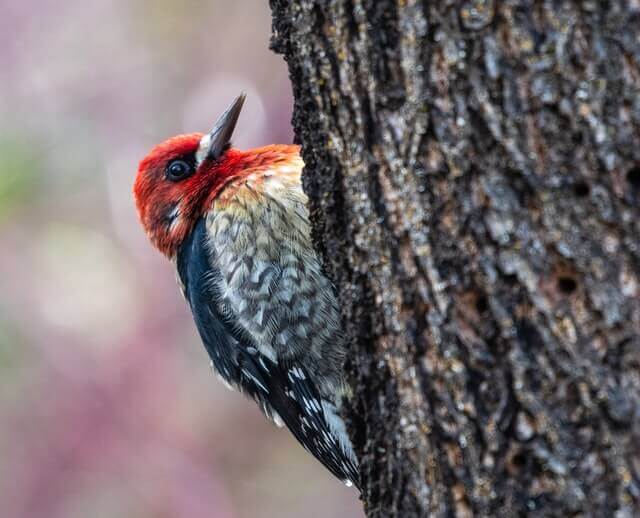
Characteristics:
- Red-breasted Sapsuckers are a small to medium-sized woodpecker species.
- They are known for their distinctive red head and throat.
- These birds have a black back and wings with white stripes.
- Red-breasted Sapsuckers have a white belly and underparts.
- They feature a short, pointed bill suitable for drilling into trees.
- Males and females have similar plumage, with minor differences in markings.
Similarities:
Similar to most woodpeckers, Red-breasted Sapsuckers use their bill to drum on trees in a rhythmic pattern. They share certain characteristics with Hairy Woodpeckers, including the black and white plumage. Both species have a white patch on their wings, which is a notable field mark.
Differences:
Red-breasted Sapsuckers are smaller than Hairy Woodpeckers. Their most distinctive feature is the red head and throat, while Hairy Woodpeckers have a solid black crown. While both species have black and white patterns, Red-breasted Sapsuckers lack the extensive black markings on the back and wings that Hairy Woodpeckers possess. Additionally, Red-breasted Sapsuckers have a red throat and crown, whereas Hairy Woodpeckers lack these red markings.
| Characteristic | Measurement |
|---|---|
| Range | Western North America, from Alaska to California |
| Habitat | Coniferous forests, mixed conifer-hardwood forests, and riparian areas |
| Length | 8.3-9.1 in (21.1-23.1 cm) |
| Weight | 1.5-1.9 oz (42.5-54 g) |
| Wingspan | 14.2-15.8 in (36-40 cm) |
Nuttall’s Woodpecker

Characteristics:
- Nuttall’s Woodpecker is a small to medium-sized woodpecker species.
- They have a distinctive black and white plumage pattern.
- These woodpeckers feature a black crown and back, along with white underparts.
- Their wings are marked with black and white bars.
- Nuttall’s Woodpeckers have a sharp, pointed bill suitable for drilling into trees.
- Males and females exhibit similar plumage.
Similarities: Like many woodpeckers, Nuttall’s Woodpeckers use their bill to drum on trees, producing a rhythmic sound. They share similarities in their black and white plumage with other woodpecker species, such as the Downy Woodpecker. These birds also have a distinctive white patch on their wings, a common feature among woodpeckers.
Differences: Nuttall’s Woodpeckers are smaller in size compared to some other woodpecker species. While their plumage is primarily black and white, specific patterns and markings may vary slightly among individuals. Unlike larger woodpeckers, Nuttall’s Woodpeckers lack extensive red or colorful plumage. Their bills are adapted for drilling into trees, similar to other woodpecker species. Overall, they have a unique combination of black and white features that distinguish them within the woodpecker family.
Sure, here’s a possible table:
| Characteristic | Measurement |
|---|---|
| Range | Northern California expanding to Baja California, as well as Mexico |
| Habitat | Wooded canyons, foothills, woodlands, riverside, willows |
| Length | 6.2 to 7.2 in (15.7 to 18.3 cm) |
| Weight | 29 to 46 g (1.02 to 1.62 oz) |
| Wingspan | 12.9-16.2 in (32.8-41.1 cm) |
This table provides a quick reference to some of the key characteristics of this bird species, including their range, habitat, length, weight, and wingspan.
Red-Naped Sapsucker

Characteristics:
- Red-Naped Sapsuckers are one of the smaller woodpecker species.
- They feature a red crown and a white vertical stripe down the wing.
- They come with stout and sharply pointed bills.
- Males have a red neck and reddish throat.
- Females have a small white patch under the bill.
Similarities:
Like almost all woodpeckers, Red-Naped Sapsuckers drum on trees in a slow and irregular pattern. Both Red-Naped Sapsuckers and Downy Woodpeckers feature a red spot on their head. These birds have quite similar bills and many small white spots on their wings.
Differences:
Red-Naped Sapsuckers are smaller than Downy Woodpeckers. While the neck of these birds is completely red, Downy Woodpeckers come up with a white neck. Red-Naped Sapsuckers feature pale underparts, but the underparts of Downy Woodpeckers are bright white.
| Characteristic | Measurement |
|---|---|
| Range | Western North America, from Alaska to Mexico |
| Habitat | Coniferous and mixed conifer-hardwood forests, aspen groves, and riparian areas |
| Length | 7.5-8.7 in (19-22 cm) |
| Weight | 1.2-1.8 oz (34-51 g) |
| Wingspan | 14.2-15.8 in (36-40 cm) |
Williamson’s Sapsucker

Characteristics:
- Williamson’s Sapsuckers are medium-sized woodpecker species.
- They have a unique and striking black and white plumage.
- These birds feature a glossy black head, back, and wings.
- Males have a prominent red throat patch, while females have a white throat patch.
- They possess a long, slender bill, well-suited for feeding on tree sap.
- Both males and females have white wing patches and white barring on their back.
Similarities:
Like many woodpeckers, Williamson’s Sapsuckers are known for their habit of drilling into trees to feed on sap. They share the black and white coloration typical of woodpeckers. Additionally, both males and females have white wing patches, which are distinctive field marks.
Differences:
Williamson’s Sapsuckers differ from other woodpeckers in their striking black and white appearance. Male Williamson’s Sapsuckers have a red throat patch, which is absent in other woodpecker species. Female Williamson’s Sapsuckers, on the other hand, have a white throat patch, distinguishing them from many other woodpecker females. Their slender bills are specialized for sap-feeding, unlike the stout bills of some other woodpeckers.
| Characteristic | Measurement |
|---|---|
| Range | Western North America, from British Columbia to Arizona and New Mexico |
| Habitat | Coniferous forests, mixed conifer-hardwood forests, and aspen groves |
| Length | 8.3-9.1 in (21-23 cm) |
| Weight | 1.5-1.9 oz (42-54 g) |
| Wingspan | 16.1-16.9 in (41-43 cm) |
Red-cockaded Woodpecker

Characteristics:
- Red-cockaded Woodpeckers are small-sized woodpecker species.
- They have distinctive black and white plumage.
- These woodpeckers feature a black cap and nape with white sides and cheeks.
- They have a small red patch, often called a “cockade,” near the eye of the male, which is absent in females and juveniles.
- Red-cockaded Woodpeckers have a short, chisel-shaped bill suited for excavating cavities in longleaf pine trees.
- Males and females have subtle differences in appearance, with males typically having a smaller red patch and a more prominent black cap.
Similarities: Similar to other woodpecker species, Red-cockaded Woodpeckers use their bill to drum on trees in a rhythmic pattern. They share some similarities with other black and white woodpeckers, such as the Downy Woodpecker, including the black and white coloration and the use of trees for foraging and nesting.
Differences: Red-cockaded Woodpeckers are smaller than many other woodpecker species, such as the Hairy Woodpecker. Their distinctive red cockade near the eye is a key identifying feature in males. Unlike Downy Woodpeckers, Red-cockaded Woodpeckers have specialized habitat preferences, primarily residing in mature pine forests, especially longleaf pine ecosystems. They are known for their cooperative breeding behavior, with family groups working together to maintain and excavate nest cavities.
| Characteristic | Measurement |
|---|---|
| Range | South Virginia all the way to Florida and West to Arkansas, Oklahoma, Texas |
| Habitat | Mature pine forests |
| Length | 7.8-9.2 in (19.8-23.4 cm) |
| Weight | 1.5-1.9 oz (42.5-53.9 g) |
| Wingspan | 14.3 in (36.3 cm) |

